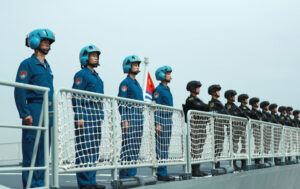The US may be losing ground to new global powers in many respects, but when it comes to the business of sowing conflict around the world, it remains unrivalled. As it slowly abandons Ukraine to its own fate, after playing a crucial role in triggering the conflict in the first place, and as it contributes to the dangerous escalation in the Middle East, it is also laying the ground for a future war with China in Asia.
For much of the past half-century, the US and its Asia-Pacific allies shunned a collective Nato-like approach to security in the region, opting instead for a so-called hub-and-spokes system: with the United States as the hub and various bilateral and multilateral alliances as the spokes of an ideal “wheel of security”. In recent years, amid growing tensions with Beijing, these initiatives have multiplied, with overlapping political, military and economic deals creating, in the words of The Economist, “an ever-thickening lattice on China’s periphery”.
The US, however, now appears determined to take this approach one step further, by transforming its patchwork of arrangements into a full-blown military alliance: an Asian Nato. The first major step in this direction was the creation, in the early days of the Biden administration, of the Australia-United Kingdom-United States pact (Aukus), a new trilateral military partnership that included, as its central pillar, the provision of nuclear-powered (but not nuclear-armed) submarines to Australia. The project was initially met with scepticism and hostility — especially, as one might have expected, from China, which said that the partnership risked “severely damaging regional peace”.
While this led to a sluggish start for the new alliance, Aukus has gained momentum in recent months. The three countries recently announced the launch of Pillar II of the pact, which will see its members collaborate on next-gen military technologies — including quantum computing, artificial intelligence, hypersonic weapons and undersea capabilities — and decide whether to invite new members, such as South Korea, Canada, New Zealand and Japan. Earlier this month, the US ambassador to Japan, Rahm Emanuel, wrote that Japan was “about to become the first additional Pillar II partner”.
Over the past year, the US and its allies in the region have emphatically denied that these moves are aimed at establishing an “Asian Nato”. However, such reassurances don’t carry much weight these days — especially in China. After all, the US is very open about the fact that it considers China to be its major “pacing threat” — and several high-ranking US officials have argued that they consider a US-China war in the coming years to be all but inevitable. Indeed, Nato itself has declared China to be a “systemic challenge”. Meanwhile, US allies in the region are deepening their relations with Nato itself through so-called Individually Tailored Partnership Programmes (ITPPs), and the leaders of Australia, Japan, Korea and New Zealand were invited as guests to a Nato summit in Lithuania last year, whose communique called out China more than a dozen times for coercive and destabilising military and economic actions.
The Western narrative is that the military build-up in the Asia-Pacific is merely a response to China’s increasingly assertive posture in the region — and is therefore about deterrence, not escalation, and shouldn’t be perceived by China as a threat. But should we expect China to take our word for it? Indeed, Beijing has made it very clear that it views Aukus, and the growing US military presence in the Asia-Pacific, as a threat — especially in light of the new US Deputy Secretary of State Kurt Campbell’s admission that “Aukus submarines are intended for a potential war with China over Taiwan”.
In this context, Campbell’s argument that Aukus will “strengthen peace and stability more generally” in the region appear naïve at best, and deceiving at worst. Indeed, it’s hard to see how pouring military machinery into an already volatile region won’t lead to the escalatory spiral that Aukus’s strengthening and expansion is ostensibly aimed at preventing: an all-out US-China war.
If all this feels familiar, that’s because it is. In many respects, what is happening with Aukus in the Asia-Pacific is reminiscent of Nato’s post-Nineties expansion towards Russia’s border. Even then, Nato claimed that its expansion was defensive in nature and shouldn’t be viewed as a threat by Russia. Yet, countless US politicians and diplomats, including George Kennan and Bill Clinton, understood that Nato expansion would become a self-fulling prophecy: regardless of Western assurances, it would create a security dilemma for Russia, and invite a retaliatory response from the latter at some point, thus engendering the very security threat that Nato expansion was purportedly defending against. This is, of course, exactly what happened, eventually leading to the tragic events still unfolding in Ukraine.
Today, a similar self-fulfilling prophecy is unfolding in the Asia-Pacific. With regard to the expansion of Aukus, the US is once again adopting the same incremental, or “salami”, tactic as it did during Nato’s expansion: it is cutting off thin slices gradually — moving in small steps — so that no single action can be used by the other side to justify a major response, while over time achieving the desired (and officially denied) outcome.
Throughout Nato’s gradual enlargement, this strategy enabled Washington to dismiss any complaints and to depict Russia’s responses as disproportionate. A similar argument is used today to dismiss Chinese concerns about Aukus’s Pillar II: the latter, the US claims, simply implies greater military-technological collaboration between allied countries, not the creation of a full-blown military alliance. But of course increasing “joint capabilities and interoperability” between countries — just as the US was doing in Ukraine in the lead-up to Russia’s invasion — is a step in that direction.
Another tactic plucked from Nato’s playbook is the “deterrence-cooperation dichotomy” — a term coined by the Norwegian political scientist Glenn Diesen to describe the way in which Nato expanded while continuing to promote cooperation with Russia in several domains. A similar approach today has been adopted in countries like Australia and New Zealand: while deepening their relations with the US and Nato in the context of avowedly anti-China military-security alliances, they continue to express their keenness to maintain solid economic ties with China.
Now, this may seem understandable: China today is the top trading partner for most US allies and partners in the Asia-Pacific region, including Australia and New Zealand. But it also speaks to the irrationality of this approach to China. After all, it’s unclear exactly how China represents a “threat” to these countries — unless one construes the end of American dominance of the Asia-Pacific region, and the rise of a more policentric order, to be an instrinsic threat, which indeed seems to be the case. As the former New Zealand PM Helen Clark asked of reports that the government is considering joining Aukus: “Why do we need a military alliance ostensibly aimed at defending us from our major trading partner? This somehow doesn’t quite add up.”
In response, local politicians might tell themselves — and their citizens — that military alliances such as Aukus don’t compromise their country’s sovereignty, and that they remain in charge of their foreign policy. However, the history of Nato tells a different story: US-led military alliances of this kind create a path dependency that makes it very hard for individual members to disentangle themselves from the foreign-policy decisions taken in Washington, even if they disagree with them. Again, the history of Nato expansion is instructive here. When President Clinton attempted to advance the deployment of strategic missile defence systems in Eastern Europe, he met strong opposition from several European countries. But Washington, as the de facto leader of the dominant security system in Europe, methodically used the demand for “alliance solidarity” to mute criticism from allies. Eventually, Nato allies fell in line — just as they did following Russia’s invasion of Ukraine.
In this sense, countries such as Australia and New Zealand would be naïve to think that they could avoid getting dragged into a future US-China conflict. Aukus means effectively surrendering their foreign policy to the US. After all, the Americans have been pretty open about the fact that they view Aukus as a Nato-like means to assert US hegemony over the region. Campbell, the chief architect of Biden’s Asia strategy, has openly admitted that Aukus is about “locking [Australia] in for the next 40 years” — i.e. subordinating it to America’s geopolitical strategy.
The Australian government has often stated that Aukus “does not involve any ante facto commitment to participate in, or be directed in accordance with, the military operations of any other country”. But they were recently rebuffed by none other than Campbell himself, who, according to the Financial Review, confirmed that “Washington would not transfer the jewel in its crown — nuclear-powered submarines — if it did not have ultimate say over their operational use, especially if a conflict arises with China”. As The Economist recently observed, Australia isn’t destined to become a sovereign partner, but “America’s military launchpad into Asia”.
Our allies in Asia are thus faced with a choice: they can either choose to exploit their unique geographical position and act as a bridge between East and West; or they can choose to become tools of American militarism and great-power confrontation. To see how the latter might end up, they only have to look to Europe.
Disclaimer
Some of the posts we share are controversial and we do not necessarily agree with them in the whole extend. Sometimes we agree with the content or part of it but we do not agree with the narration or language. Nevertheless we find them somehow interesting, valuable and/or informative or we share them, because we strongly believe in freedom of speech, free press and journalism. We strongly encourage you to have a critical approach to all the content, do your own research and analysis to build your own opinion.
We would be glad to have your feedback.
Source: UnHerd Read the original article here: https://unherd.com/



